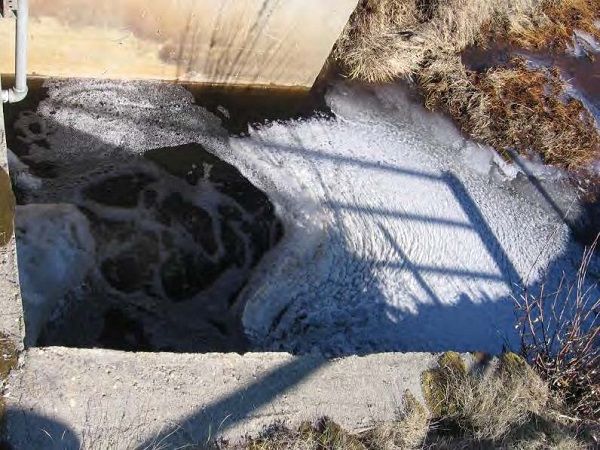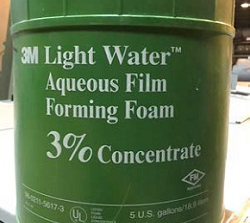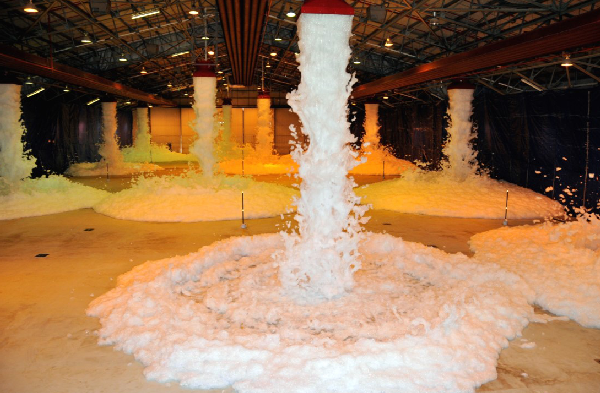Aqueous Film Forming Foam (AFFF)
Aqueous Film Forming Foam (AFFF) is a fire suppressant used to extinguish flammable liquid fires such as fuel fires.
AFFF is often used in shipboard and shore facility fire suppression systems, fire fighting vehicles, and at fire training facilities. AFFF is purchased as a concentrate, typically referred to as “3%” or “6%” (Type 3 or Type 6, respectively) depending on its mixture ratio with water.
PFAS, PFOS, and PFOA
Per- and poly-fluoroalkyl substances (PFAS) are a large family of human-made chemicals that have been widely used in industry and consumer products since the 1950s. Perfluorooctane sulfonate (PFOS) is a long-chain PFAS found in older stocks of AFFF and as a breakdown product of precursor compounds. Perfluorooctanoic acid (PFOA) is also a long-chain PFAS. PFOA is not an intended ingredient in AFFF, but is a side product created during the manufacturing process. Many AFFF formulations contain other unintended PFAS side products that have similar health and environmental concerns.

Release of foam to the Garrison slough (courtesy: Stacey Ri and Ron Porter. CH2MHill 2015)
Regulations for PFAS in AFFF
DEC has identified PFOS and PFOA and several other PFAS found in AFFF as hazardous substances and established regulatory soil and groundwater cleanup levels for both PFOS and PFOA. Any discharge of PFAS-containing AFFF must be reported immediately to the State under 18 AAC 75. To report a new release or spill, contact: (800) 478-9300 or reportspills.alaska.gov.
When AFFF is used, discharged or released to the environment, containment and cleanup may be required to prevent future adverse health or environmental impacts.
PFOS and PFOA are designated as hazardous substances under the Comprehensive Environmental Response, Compensation, and Liability Act (CERCLA).
DEC strongly encourages all AFFF users to implement best management practices (BMPs) on selection, storage, use and disposal. Examples of BMPs are available in the reference section below.

PFAS-Containing AFFF
Due to their long shelf lives, older AFFF (including PFOS-based AFFF concentrate) may still be present in your inventory. Common product names or attributes include:
- 3M Light Water AFFF (PFOS-based)
- Long-chain PFAS containing C-8, 10, 12, or greater fluorochemicals
If the product name and/or purchase date cannot be determined, a sample can be sent to an analytical laboratory to determine the presence or absence of PFOS, using EPA Method 537 or another method recommended by an environmental laboratory. Users are advised to compare sampling costs and disposal costs, as it may be more cost-effective to properly dispose of limited quantities of unknown PFOS material rather than pay for sampling and analysis.
How to Dispose of PFAS-Containing AFFF
AFFF must be disposed of properly. AFFF may not be disposed of at sea, in any landfill in Alaska, or through septic, stormwater, or municipal sewer systems. When shipping PFAS-containing AFFF out of state, use a licensed waste transportation and disposal company. For more information about proper disposal of AFFF read the EPA's Interim Guidance on the Destruction and Disposal of Perfluoroalkyl and Polyfluoroalkyl Substances and Materials Containing Perfluoroalkyl and Polyfluoroalkyl Substances.
Eligible Alaskans may be able to receive a reimbursement for costs related to the disposal of AFFF through DEC's Firefighting Substance Disposal Reimbursement program.
Stockpiles of PFOS-Based AFFF
Older PFOS and long-chain PFAS AFFF should only be used in emergencies where insufficient amounts of newer short-chain AFFF or other foams are available and where there is an immediate risk to human life, public safety or property. DEC strongly recommends these older products be removed from use and properly disposed. Newer formulations may still be hazardous to human health and the environment and should only be used when necessary to prevent immediate threat to life or health.
Manufacturing History of AFFF
Prior to 2002, many fluorosurfactants used in AFFF were PFOS-based, which resulted in AFFF that contained PFOS and precursors compounds that could transform into PFOS, PFOA and other PFAS of concern. During that time, AFFFs based on long-chain fluorotelomers were also available. After 3M, Inc.’s announcement to phase out manufacturing of PFOS-based products in 2000, the primary supply of AFFF became fluorotelomer-based. By 2015, manufacturers of fluorotelomer AFFF replaced long-chain fluorosurfactants with short-chain fluorosurfactants. The PFAS in current fluorotelomer-based AFFF are shorter chain molecules and are suspected to be less toxic. Telomer-based AFFF does not contain PFOS, but may contain trace amounts of PFOA and can break down into other PFAS.
In recent years, some firefighting foam producers have been moving away from AFFF in favor of fluorine-free foam, commonly called F3. These foams do not contain intentionally added PFAS. Some users have been able to start phasing out AFFF in favor of fluorine-free foam to avoid the hazards associated with PFAS. However, fluorine-free foams are not “film-forming” and the mechanics of how they extinguish a fire is different from AFFF.
Historic Uses and Releases of PFAS-Containing AFFF
Throughout Alaska, DEC has identified PFAS contamination that is above cleanup levels and associated with releases of AFFF. Releases may have occurred at firefighting training locations, AFFF storage tanks and transport lines, accident/emergency response sites, and near facilities (e.g., aircraft hangars) with AFFF fire suppression systems.
If you or your agency would like to conduct groundwater sampling for these chemicals or if your records indicate your facility may have experienced AFFF leaks, spills, or releases to the environment, please contact the DEC Contaminated Sites Program at 907-465-5250.


 Indicates an external site.
Indicates an external site.